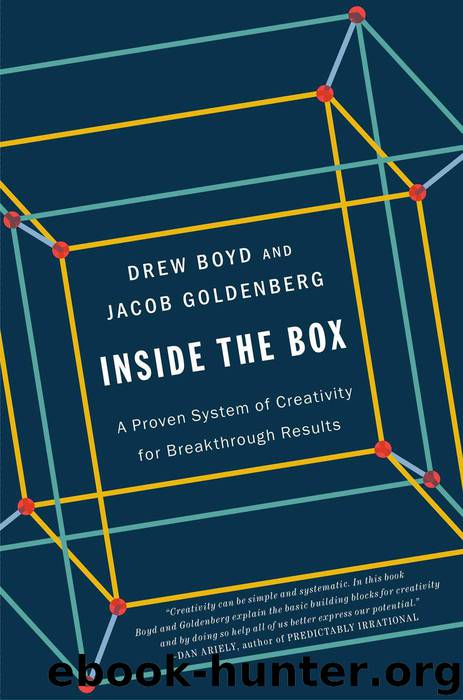Inside the Box: A Proven System of Creativity for Breakthrough Results by Drew Boyd & Jacob Goldenberg

Author:Drew Boyd & Jacob Goldenberg [Boyd, Drew]
Language: eng
Format: mobi
Publisher: Simon & Schuster
Published: 2013-06-10T14:00:00+00:00
NEW TRICKS FOR OLD DOGS: THE TASK UNIFICATION TECHNIQUE
What we are familiar with, we cease to see.
—Anaïs Nin
Dr. Steven Palter’s patient began to cry. Not because of the sharp pain that suddenly shot through her abdomen—after years of suffering she was used to that—but from sheer relief. The Yale University fertility specialist had precisely isolated the physical source of his patient’s chronic pelvic pain (CPP). “We got it!” Dr. Palter said elatedly, and immediately released the pressure he’d put on the spot inside her abdomen. “And we couldn’t have found it without you,” he told the woman. For years, she’d been in constant agony that prevented her from sleeping, holding a job, or maintaining even the semblance of a normal family life.
After the patient and Dr. Palter together had identified the location and source of her pain, the doctor made a “conscious pain map.” Immediately thereafter, Dr. Palter used this map to guide his surgery on his patient, using a laser to precisely remove the diseased tissue he could not see with his naked eye alone, finally relieving the woman from the endless rounds of physician referrals, diagnostic tests, and failed treatments.
Dr. Palter and his patient had embarked on a new kind of surgery called conscious pain mapping. It was the patient who, as a member of the surgical team, identified the area of pathology.
This particular patient was extraordinarily lucky to have found Dr. Palter. Although 20 percent of women suffer from CPP at some point in their lives—with one of every ten outpatient referrals to gynecological specialists due to this condition—only 60 percent of cases are diagnosed accurately. Even fewer are treated successfully. Most CPP sufferers find their lives altered irrevocably because of the severity of the pain, and many struggle to cope with depression on top of the physical anguish.
CPP has also long frustrated physicians. Although some doctors have suspected that factors such as endometriosis and irritable bowel syndrome can cause CPP, it has always been difficult to make a definitive diagnosis. Seemingly diseased tissue would prove benign and vice versa. And without such a diagnosis, CPP is nearly impossible to treat.
Or was. Until Dr. Palter had his idea.
Before Dr. Palter’s innovation, the gold standard diagnostic tool had been laparoscopy. This involves inserting a small video camera through a small incision in a patient’s abdominal wall to get an internal view of her ligaments, fallopian tubes, small and large intestines, and pelvic sidewalls, and the uppermost portion of the uterus, or fundus. But since CPP pain occurs often in seemingly normal tissue, it frequently can’t be detected from visual clues alone (the wrong color, unusual spots or texture, and so on). Therefore, laparoscopy results are at best ambiguous, can be a waste of time, and, at worst, lead to the removal of normal tissue that isn’t even responsible for the pain.
Dr. Palter decided to systematically map the inside of a patient’s abdomen by physically touching one spot after another until the patient felt pain. Once he isolated the
Download
This site does not store any files on its server. We only index and link to content provided by other sites. Please contact the content providers to delete copyright contents if any and email us, we'll remove relevant links or contents immediately.
Hit Refresh by Satya Nadella(9083)
The Compound Effect by Darren Hardy(8870)
Change Your Questions, Change Your Life by Marilee Adams(7684)
Nudge - Improving Decisions about Health, Wealth, and Happiness by Thaler Sunstein(7657)
The Black Swan by Nassim Nicholas Taleb(7056)
Deep Work by Cal Newport(6966)
Rich Dad Poor Dad by Robert T. Kiyosaki(6513)
Daring Greatly by Brene Brown(6473)
Principles: Life and Work by Ray Dalio(6296)
Playing to Win_ How Strategy Really Works by A.G. Lafley & Roger L. Martin(6084)
Man-made Catastrophes and Risk Information Concealment by Dmitry Chernov & Didier Sornette(5956)
Digital Minimalism by Cal Newport;(5704)
Big Magic: Creative Living Beyond Fear by Elizabeth Gilbert(5677)
The Myth of the Strong Leader by Archie Brown(5457)
The Slight Edge by Jeff Olson(5376)
Discipline Equals Freedom by Jocko Willink(5336)
The Motivation Myth by Jeff Haden(5175)
The Laws of Human Nature by Robert Greene(5080)
Stone's Rules by Roger Stone(5052)
